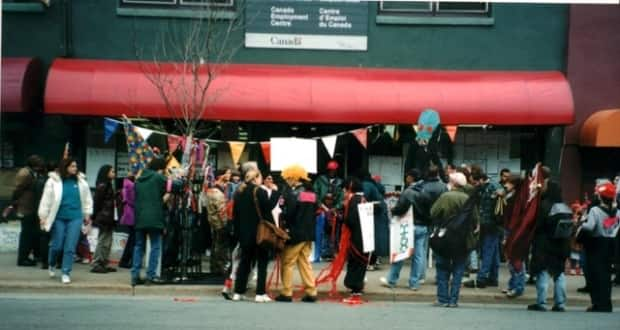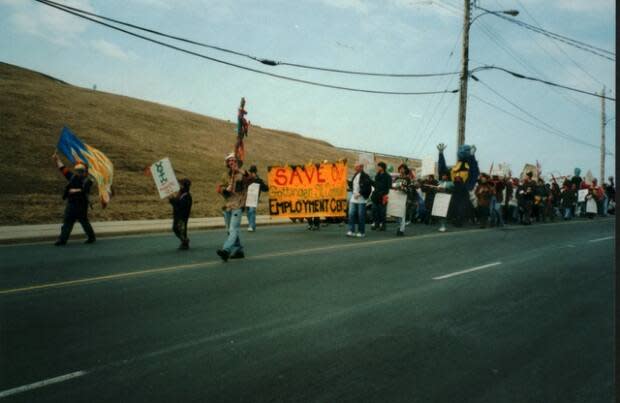How an occupation in north-end Halifax saved the community from gentrification

Fed up with gentrification in north-end Halifax in 1996, community members walked into one of the last remaining businesses on Gottingen Street and refused to leave.
It was the start of an occupation that would last more than 100 days and nights, and spur change that is still being felt in the area 25 years later.
"There had been this erosion of the community that was happening right before its eyes," Shelley Fashan, who participated in the occupation, told CBC's Mainstreet on Thursday.
The predominantly Black community witnessed its local grocery store, movie theatre, post office and bank shut down.
The federal government was trying to eliminate deficits by cutting budgets, and the last remaining community hub on Gottingen Street, the Canada Employment Office, was next on the chopping block.

The office had been a critical resource in the community for nearly 30 years, helping to address poverty, racism in hiring and discrimination based on class and education levels.
It was scheduled to close at the end of March. Some staff were being laid off and services were being relocated to the Halifax Shopping Centre in the west end.
"They were planning to take this out of the community and the community said, 'This is the last straw,'" Fashan said, adding that many people in the area didn't have their own vehicle and couldn't afford to regularly use transit.
The occupation began on March 27 when Fashan, a young Black woman, walked into the Canada Employment Office and waited.
She later opened the locked door to about 50 others, including activists, neighbours and union members with the Black Community Work Group.
Carolann Wright was among that group. She along with several other activists, including Rocky Jones, Joan Jones and Lynn Jones, had planned the occupation after watching the "beginning of gentrification" on Gottingen Street.
"The incredible thing is, as soon as the call was made that that was the strategy, there was no further debate," Wright told Mainstreet.
"Nobody said, 'Well, I don't think we should do it.' It was just like, 'OK, this is what we're doing. This is how we're doing it.'"
Their goal was to remain in place until Human Resources Development Canada, which operated the office, became receptive to the "needs and aspirations of the community with regard to employment."
They also wanted the office to remain open until a new location was established that was accessible to the community.
With negotiations ongoing, the sit-in continued for weeks, then months.

Services continued in the office as employment counsellors volunteered to offer their services.
The community rallied around the office. Speakers and musicians visited to keep the occupiers entertained, food was provided by community members and artists even came in to decorate the space.
"It was a vibrant [space]. The energy was just incredible," Fashan said.
Support continued to grow as time passed, and the occupiers never waned in their efforts.
By the end of July, the occupation proved successful.
The federal government agreed to temporarily reopen the employment office with full service and promised to complete a joint study into the area's employment needs.
"It's been a very intense struggle and a major victory for the community," Wright told The Daily News on July 27, 1996.

"The community needed some kind of affirmation that they were really important, that they really mattered, and that people just can't fold up their tents and walk out of the community without some accountability."
The sit-in lasted 133 days and nights. It continues to be the longest running occupation of a federal government office in Canadian history.
Now, 25 years later, Gottingen Street has grown and continues to thrive.
"It was important to have that win. It was important for the community who were involved to see that we could change that decision," Wright said.
"We had an influence on that decision and that's what agency looks like. This is what we need in our community."
Wright said the 25th anniversary of this occupation is a reminder that Black communities are still fighting.
She said she was discouraged after two Black ministers, Tony Ince and Késa Munroe-Anderson, were replaced with white individuals following the most recent provincial election.
"It's the same battle. It's about agency. It's about us knowing what's best for us. The community does its work ... our Black organizations work on behalf of our communities ," she said.
"This is like rolling back a boulder over us in terms of having this happen."
Although she's saddened by this, Wright said she's looking forward to celebrating the 25th anniversary of the successful occupation.
A tribute concert, called How We Won, is being held at the Derby Showbar on Gottingen Street on Friday evening. It will feature storytelling, music and spoken word poetry from former occupiers and supporters.
For more stories about the experiences of Black Canadians — from anti-Black racism to success stories within the Black community — check out Being Black in Canada, a CBC project Black Canadians can be proud of. You can read more stories here.

MORE TOP STORIES

 Yahoo Movies
Yahoo Movies 